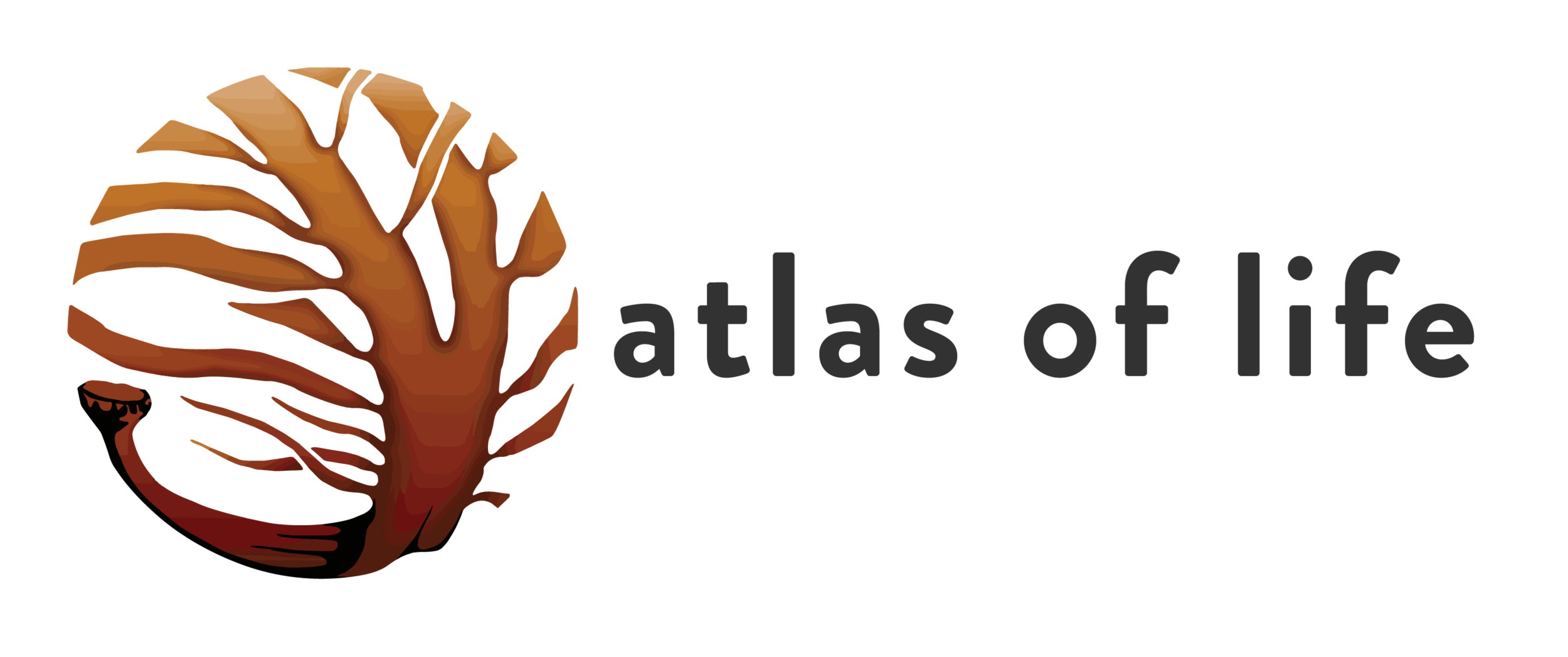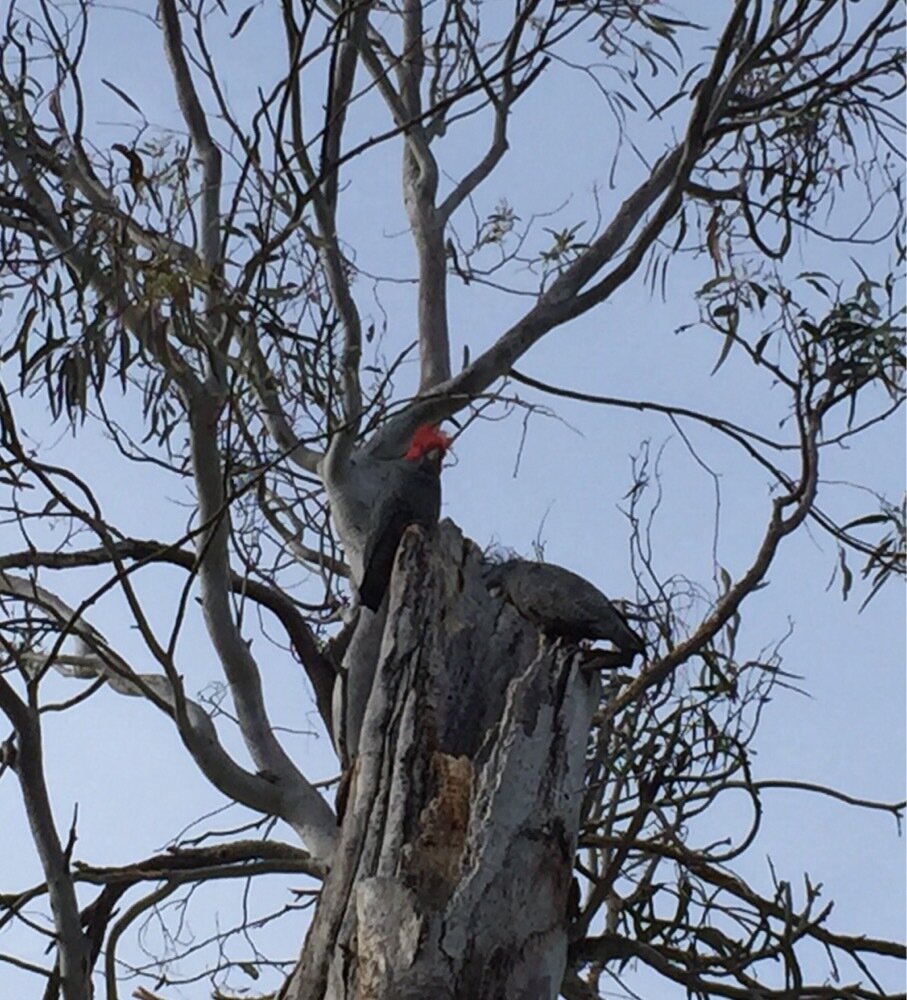SPECIAL PROJECT
Gang-gang nesting project
The Atlas of Life Coastal Wilderness, Budawang Atlas of Life and Canberra Nature Map are joining together in a research project to record the nesting and feeding behaviour of Gang-gang Cockatoos across our regions
We invite you to join this project. If you are interested please complete this form: Gang-gang nesting research project 2021
photo Roy McDowall
This project follows and extends successful research carried out in the ACT.
We are looking for people who want to find out more about Gang-gangs on the south coast, particularly what they are eating, where they are nesting, the rate of nesting success and how that success is influenced by factors thought to be impacting negatively on the Gang-gang such as brush-tail possum predation, hollow competition from Sulphur Crested Cockatoos and other species, overheating in hollows and flooding of hollows. This information will help inform the conservation of this bird and lead to the implementation of action as to how its dramatic decline (around 70% in less than 30 years) may be turned around.
We will be gathering information about Gang-gangs that is currently unknown and co-ordinating our research with work undertaken elsewhere across the Cockatoo’s range, so that results in our area can be compared with that of other places and habitat such as burnt/unburnt urban/remote, using data from several different locations. There are different levels and kinds of contribution you can offer, from making observations, putting out motion sensitive cameras and recording what’s in tree hollows, to helping to ID the birds and their feed trees and analysing motion sensitive camera images.
Here is the recording of the 2021 Science Week presentation about the findings to date from this Gang-gang nesting research project in ACT. Michael Mulvaney and Stacey Taylor presenting the Gang-gang research
The Gang-gang CockatoO (Callocephalon fimbriatum) is about to be listed as one of the more threatened species of cockatoo in Australia. It is already listed as vulnerable in NSW.
Help to map these special birds and their habitats by recording sightings anywhere across south-eastern NSW & the ACT
We are mapping the distribution of Gang-gang cockatoos, the location and activity around suitable nest hollows and their feeding habits.
What to record & photograph
The location, the number of birds (including sex & age - adult/juvenile - if apparent), and their behaviour at the time. Try to photograph the birds - even an image from a distance may be sufficient to confirm the identification. We are also interested in what they are feeding on.
What to record & photograph
You need to be a registered iNaturalist contributor to be able to add to our research.
If you see Gang-gangs near a tree hollow, go to the Gang-gang nesting project on iNaturalist and answer as many questions as you can. If you see Gang-gangs feeding go to the Hungry Parrots project and record what you see there.
RECORDING A SIGHTING WITHOUT A PHOTO - FOR EXPERIENCED BIRD WATCHERS
Most iNaturalist sightings require a photograph. We recognise, however, that many experienced 'birders' are able to confidently identify a bird based on sight or call alone. We are keen to include such records. If you are confident in your identification, please go ahead and add a sighting to iNaturalist. We simply ask that in the comments field you describe what you based your identification on, including how you excluded similar, candidate species. Also, please note your level of experience (e.g. "active member of Far South Coast Birdwatchers for many years").
Recognising potential nest hollows
In our Gang-gang nesting project we are keen to identify trees which could be nesting sites for Glang-gangs and the birds’ behaviour around those hollows. Understanding critical factors about their behaviour and needs is the first step towards working out how we can help their populations recover. Protecting suitable nest sites is critical to saving this species.
What to record & photograph
Photograph any such hollow-bearing trees that you locate - even if you see no evidence of Gang-gang Cockatoos in the area - and record this on iNaturalist. Make note of the type of hollow, the species of tree (include photos of the bark and, if possible, leaves, fruit or flowers), and the diameter of the tree at breast height (DBH). If you can’t determine the species of tree, simply add Gang-gang nesting project, tree hollow in the notes.
Recognising the birds
Most people recognise a cockatoo, and Gang-gang cockatoos are a seen across many parts of south-eatstern Australia. The Gang-gang Cockatoo (Callocephalon fimbriatum) is seen infrequently in most places and its poulation decline of over 70% in the last few years has caused it to be a strong contender as an endangered species.
This is why it is important that we help to record its presence and observe its important behaviour, with a view to putting in place measures to help its poulations recover.
Click the images below to enlarge, and 'hover' for image details
Photos by Roy McDowall, Max Campbell , Leo Berzins, Liz Allen, Jon Birds in Canberra
Some features to look for in recognising Gang-gang Cockatoos
Small(33-36cm) and stocky
Males have the distinctive red head with a crest of feathers. Generally mid-grey but with barring and edges paler with females in addition having yellow/pink on edges of chest feathers.
Females also have a crest but it’s the same colour as their body. Juveniles are the same all over slate grey colour as the females
Rounded strong parrot beak.
Broad wings and short tail
Gregarious but quiet.
Distinctive “creaky gate “ call
Where to look for Gang-gang Cockatoos
Gang-gangs range across south eastern Australia. In the summer months, they are mostly found at higher elevations, where they breed in tree-hollows. After breeding has finished, they travel to lower elevations in autumn and winter, when they can often be seen in gardens. In autumn we can often see groups of Gang-gangs visiting Panboola where they feed on Hawthorn berries.
Small groups will sit quietly, chewing on the fruit, sometimes remaining in the same tree for hours. In fact the squeaking and cracking of their feeding is often the first indication of their presence. Such feasting also leaves tell-tale evidence on the ground.
NOW SIMPLY UPLOAD YOUR SIGHTINGS!
All sightings are recorded using our iNaturalist database in Atlas of Life Coastal Wilderness and Budawang Atlas of Life. In the Canberra region, add your sightings to the Canberra Nature Map. Simply select the appropriate region for your sighting from the links below:
The region covered by the project
The Gang-gang nesting project involves the Atlas of Life: Coastal Wilderness, Atlas of Life: Budawang Coast, and Canberra Nature Map. This will provide valuable data for conservation of the species.
Surveys of Gang-gang Cockatoos are challenging, as the birds are often in forested and remote areas. This is where citizen science can help. The more people out there, keeping an eye out and then reporting their sightings, the better!
ANY QUESTIONS?
If you have any questions about this project, please contact the project leader:
Michael Mulvaney - mulvaney@netspeed.com.au
OTHER RESOURCEs, references & Links
OEH information on Gang-gang Cockatoos
Birdlife Australia description: Gang-gang Cockatoo
World Parrot Trust : Gang-gangs
Sound recordings can be heard here : http://www.xeno-canto.org/species/Callocephalon-fimbriatum
Papers on the subject:
Davey, C., Mulvaney, M., Fogerty, J., Tyrrell, T., and Tyrrell, J. (2019) Breeding of Gang-gang Cockatoo in suburban Canberra. Canberra Bird Notes 44: 210-220.
http://canberrabirds.org.au/wp-content/uploads/2020/01/CBN-44-3-final.pdf
Davey, C, and Mulvaney, M. (2020) Report on a survey of breeding activity of the Gang-gang Cockatoo within urban Canberra 2019-2020. Canberra Bird Notes 45: 224-231.
http://redhillregenerators.org.au/wp-content/uploads/2020/08/Canberra-Bird-Notes-453-2020.pdf
Davey, C. (2021). Observations of a Gang-gang pair nesting at the Pinnacle Nature Reserve. Canberra Bird Notes 46: 85-86.
http://canberrabirds.org.au/wp-content/uploads/2021/05/CBN-46-1-final-for-web2.pdf























